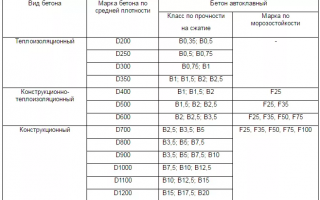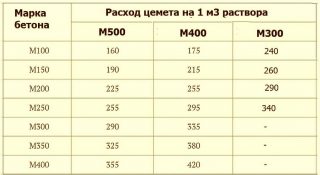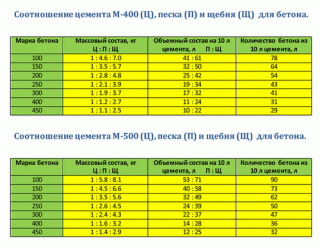Concrete is a well-known building material. Its characteristics vary over a very wide range: from minimally strong but warm wood-based concrete to ultra-strong and heavy concrete. The properties of the material determine its composition: the ratio of cement, sand and crushed stone.
Concrete grades for various purposes

Different materials are required for the foundation, supporting structure or insulated interior partition. Moreover, they differ in many parameters: resistance to frost, density, resistance to bending load.
By strength, that is, according to the value of the ultimate bearing load, the following are distinguished brands:
- M-100 - for auxiliary procedures, for example, for laying a pillow under the foundation;
- M-150 - for screed and floor filling;
- M-200 - for the construction of foundations, blind area, floor in the garage;
- M-250 and M-300 - for pouring a monolithic foundation, stairs, fences and ceilings;
- M-350 - for the construction of heavy slabs, floors, foundations, columns, pool bowls;
- M-400 - for the construction of bridges, cash storages, dams;
- M-450, M-500, M-550 - for the construction of dams, dams, metro;
- M-600 - for the construction of the most loaded and critical structures operating in an aggressive environment.

An equally important parameter is average density mortar. The indicator determines the thermal conductivity of the stone, weight, resistance to stress. There are the following brands:
- D500 - porous concrete, used for thermal insulation and the construction of partitions;
- D500- D1800 - structural and heat-insulating material, used for buildings with a small load;
- D1800- D2200 - a standard option for the construction of residential multi-storey buildings, foundations;
- D2200 - D2500 - the filler is granite and limestone, such a heavy material is taken for the construction of bearing supports;
- D2500 and up - iron shavings, magnetite are used for filling; such material is used for the construction of special facilities, for example, a gas station.
Concrete is distinguished by other characteristics, for example, by resistance to frost and to the action of water, but these characteristics are determined not so much by the composition of the main ingredients as by additives and manufacturing technology.
What determines the consumption of cement
Consumption of cement for 1 m³ of concrete also depends from the production time... The fresher the binder is, the better it exhibits its qualities. The material is never bought in advance, since as it approaches the end of the shelf life, its grade decreases and more will be needed to make 1 cubic meter.
The proportion of cement also depends from the purpose of the material... In order for the structure to harden as quickly as possible, its content is increased.
Proportions of cement, water, sand when mixing mortar
The correct ratio of cement, sand and water is determined by through tests and trials.
- Consistency - one of the main visual indicators.The "correct" concrete is held on the surface of the trowel, slowly flowing from it. Most often, this structure is called creamy. If the composition flows from a shovel or trowel, all components must be added to the solution proportionally to reduce the amount of water.
- A sign of excess water - glossy shine of the mixture, exfoliation, cracking. The reason is most often sand, whose moisture content was not taken into account in the calculations. Correct the error in the same way - add ingredients. It is not out of place to add plasticizers.
- If the concrete cracks when standing - This is a symptom of a lack of water. The liquid is added in small portions and mixed.
- Loose solution, low viscosity at normal density - excess sand. Add cement and water to the solution.

Methods for calculating cement per cube of concrete
Cement consumption per 1 cube of concrete is performed in different ways. It is not difficult, but you need to correctly determine the original proportions.
Arithmetic
Let's say you need to prepare concrete M200 from M400:
- The proportions are as follows: 1: 2.8: 4.8, that is, 1 + 2.80 + 4.80 = 8.60. The material cube consists of 8.6 parts.
- The total mass of a cube of concrete is 2200 kg. Dividing into fractions, a mass of 1 part of 2200 is obtained: 8.6 = 255 kg.
- Accordingly, the binder will need 255 kg, sand - 714 kg, and crushed stone - 1224 kg.
How much water is needed is determined during kneading.
Tabular
You can use the construction guide, where the necessary ratios have already been calculated. In this case, the result is in the table at the intersection of the column with the concrete grade and the row with the cement grade.
Cement grade | Ready concrete grade | |||
| M75 | M100 | M150 | M200 | |
| M400 | 195 kg | 250 Kg | 345 kg | 445 kg |
| M500 | 155 kg | 200 Kg | 275 kg | 355 kg |
Online calculator
You can calculate the required volume using the online calculator on the construction site. The necessary data is entered into the columns - the grade of concrete and cement, and the result is obtained in the form of the required amount of all components.
Calculation of the number of bags of cement for the foundation
Cement is usually sold not in cubes, but in packages of 40 and 50 kg. During the stand, it becomes necessary to calculate how many bags of binder are needed for 1 cube of concrete.
For example, for M200 concrete, according to the calculations already made, M400 cement needs 255 kg. Taking 6 bags of 50 kg is clearly unprofitable. The situation is no better with 7 bags of 40 kg. They act differently: they buy 4 packages of 50 kg each, 1 - 40 kg each and a small package of 25 kg.












